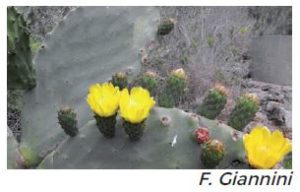 Common name: Prickly pear
Common name: Prickly pear
Scientific name: Opuntia ficus-indica, O. stricta
Brief description: Both species are part of the category of prickly pears named “Platyopuntia”, as the branches of the stem, named pads, are flat in shape. Opuntia stricta is smaller compared to O. ficus-indica (which can reach 5 metres in height) and prostrate, with a maximum heights of 2 metres. The pads, in both cases oval and flat, are smaller and more numerous in O. stricta; the spines are long in O. ficus-indica, while they are small, hooked, and gathered in tufts in O. stricta. O. ficus-indica is characterised by yellow-orange flowers and oval fruits, between 10 and 15 centimetres in size, covered in spines that take on a typically orange colour when the fruit is ripe. In O.stricta the flowers are yellow and the fruits (smaller than those of ficus-indica) are red-violet.
Biology and ecology: Suited to living in arid and pre-desert climates, it also withstands rather low temperatures for short periods of time. The root system develops superficially but in a widespread manner. A particular characteristic of this species is its ability to, at any time, generate new roots from the pads that have been detached from the stem and fallen to the ground, even in the presence of little land. Prickly pears are able to spread far away from the mother plant thanks to seeds transported by mammals (rats in particular) and by birds that avidly feed on their fruits.
Distribution in the Tuscan Archipelago and introduction: In general Opuntia, part of the Cactaceae family, has around 200 species which all originate from the American continent. At least 9 species are present in the Archipelago; Opuntia ficus-indica is the most well-known species and widespread almost anywhere due to the edibility of its fruits. Opuntia stricta is however found on the Islands of Capraia, Giglio and Pianosa.
Impact: Prickly pears are generally considered to be one of the most invasive and harmful species in the world. Among these, O. ficus-indica and O.stricta are two of the most dangerous and are therefore included in all lists for attention drawn up in the various countries or continents.
Management in protected areas: At Capraia the Park has carried out some experimental interventions to test the efficacy of different techniques for the control of the O.stricta prickly pear.




